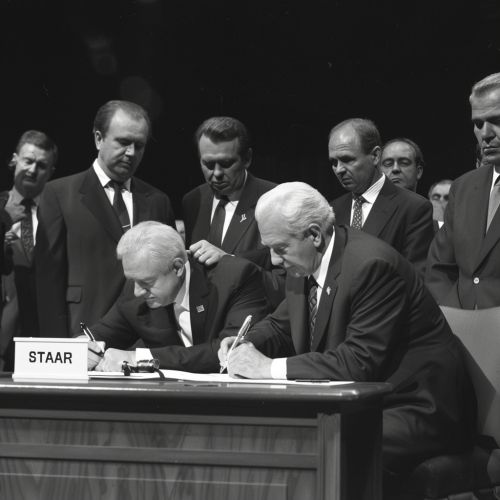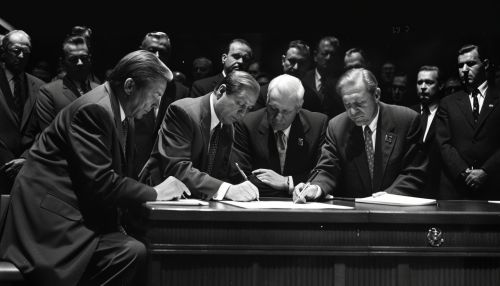Strategic Arms Reduction Treaty (START): Difference between revisions
(Created page with "== Strategic Arms Reduction Treaty (START) == The Strategic Arms Reduction Treaty (START) was a bilateral treaty between the United States and the Soviet Union (later Russia) on the reduction and limitation of strategic offensive arms. The treaty was signed on July 31, 1991, and entered into force on December 5, 1994. START was a major milestone in the efforts to reduce the nuclear arsenals of the two superpowers and to enhance global security. <div class='only_on_desk...") |
No edit summary |
||
| Line 3: | Line 3: | ||
The Strategic Arms Reduction Treaty (START) was a bilateral treaty between the United States and the Soviet Union (later Russia) on the reduction and limitation of strategic offensive arms. The treaty was signed on July 31, 1991, and entered into force on December 5, 1994. START was a major milestone in the efforts to reduce the nuclear arsenals of the two superpowers and to enhance global security. | The Strategic Arms Reduction Treaty (START) was a bilateral treaty between the United States and the Soviet Union (later Russia) on the reduction and limitation of strategic offensive arms. The treaty was signed on July 31, 1991, and entered into force on December 5, 1994. START was a major milestone in the efforts to reduce the nuclear arsenals of the two superpowers and to enhance global security. | ||
[[Image:Detail-93139.jpg|thumb|center|Leaders of the United States and Soviet Union signing the START treaty.|class=only_on_mobile]] | |||
[[Image:Detail-93140.jpg|thumb|center|Leaders of the United States and Soviet Union signing the START treaty.|class=only_on_desktop]] | |||
=== Background === | === Background === | ||
Latest revision as of 01:03, 22 June 2024
Strategic Arms Reduction Treaty (START)
The Strategic Arms Reduction Treaty (START) was a bilateral treaty between the United States and the Soviet Union (later Russia) on the reduction and limitation of strategic offensive arms. The treaty was signed on July 31, 1991, and entered into force on December 5, 1994. START was a major milestone in the efforts to reduce the nuclear arsenals of the two superpowers and to enhance global security.


Background
The origins of START can be traced back to the Cold War era, a period marked by intense rivalry and the arms race between the United States and the Soviet Union. The accumulation of nuclear weapons and the development of intercontinental ballistic missiles (ICBMs) had created a precarious balance of power, often referred to as mutual assured destruction (MAD).
Efforts to control and reduce nuclear arms began in the 1960s with the Strategic Arms Limitation Talks (SALT), which led to the SALT I and SALT II agreements. However, these agreements primarily focused on limiting the growth of nuclear arsenals rather than reducing them. The concept of actual reductions in strategic nuclear weapons was first seriously pursued in the 1980s, leading to the initiation of START negotiations.
Negotiations
START negotiations began in 1982 under the Reagan administration. The negotiations were complex and protracted, involving numerous technical and political challenges. Key issues included the verification of compliance, the counting rules for different types of delivery systems, and the limits on various categories of strategic weapons.
One of the major breakthroughs in the negotiations was the agreement on the principle of "equal reductions," which meant that both sides would reduce their strategic arsenals to equal levels. This principle was crucial in overcoming mutual suspicions and ensuring that neither side would gain a strategic advantage.
The negotiations also addressed the issue of multiple independently targetable reentry vehicles (MIRVs), which are missiles equipped with multiple nuclear warheads that can be aimed at different targets. The treaty placed limits on the number of MIRVed ICBMs and submarine-launched ballistic missiles (SLBMs).
Provisions of the Treaty
The START treaty contained several key provisions aimed at reducing and limiting strategic offensive arms:
- **Warhead Limits**: The treaty limited each side to a maximum of 6,000 accountable warheads. This included warheads on ICBMs, SLBMs, and heavy bombers.
- **Delivery Vehicle Limits**: Each side was limited to 1,600 strategic nuclear delivery vehicles, which included ICBMs, SLBMs, and heavy bombers.
- **Verification Measures**: The treaty established a comprehensive verification regime, including on-site inspections, data exchanges, and the use of national technical means (NTM) of verification, such as satellite surveillance.
- **Elimination of Systems**: The treaty required the elimination of certain types of strategic delivery systems, including older ICBMs and heavy bombers.
The treaty also included provisions for the conversion or elimination of strategic delivery vehicles and the reduction of deployed warheads. These measures were designed to ensure that the reductions were real and verifiable.
Implementation and Compliance
The implementation of START involved a series of phased reductions and verification activities. Both the United States and Russia undertook significant efforts to dismantle and eliminate strategic delivery systems and warheads in accordance with the treaty's provisions.
Verification played a critical role in ensuring compliance with the treaty. On-site inspections allowed each side to verify the other's declarations and to monitor the destruction of strategic systems. The use of NTM, such as reconnaissance satellites, provided additional means of verification.
The treaty also established the Joint Compliance and Inspection Commission (JCIC), which served as a forum for resolving implementation issues and addressing compliance concerns. The JCIC facilitated communication and cooperation between the two sides, helping to build trust and confidence in the treaty's implementation.
Impact and Legacy
START had a significant impact on the strategic nuclear arsenals of the United States and Russia. By the end of the treaty's implementation period, both sides had reduced their strategic warheads and delivery vehicles to the agreed limits. The reductions achieved under START contributed to a more stable and predictable strategic environment.
The treaty also set a precedent for future arms control agreements. The principles and verification measures established by START influenced subsequent treaties, including the Strategic Offensive Reductions Treaty (SORT) and the New START treaty. These agreements built on the foundation laid by START and continued the process of reducing and limiting strategic nuclear arms.
START also had broader implications for international security and non-proliferation. By demonstrating the willingness of the two largest nuclear powers to reduce their arsenals, the treaty reinforced the Nuclear Non-Proliferation Treaty (NPT) and contributed to global efforts to prevent the spread of nuclear weapons.
Challenges and Criticisms
Despite its successes, START faced several challenges and criticisms. One of the main criticisms was that the treaty did not address non-strategic (tactical) nuclear weapons, which remained outside the scope of the agreement. Critics argued that the exclusion of tactical nuclear weapons left a significant category of nuclear arms unregulated.
Another challenge was the issue of compliance and verification. While the treaty established robust verification measures, there were occasional disputes and concerns about compliance. These issues were generally resolved through the JCIC, but they highlighted the complexities of verifying arms control agreements.
The geopolitical context also posed challenges to the treaty's implementation. The dissolution of the Soviet Union in 1991 led to the emergence of new states with nuclear capabilities, including Ukraine, Belarus, and Kazakhstan. These states inherited portions of the Soviet strategic arsenal, and their participation in the treaty had to be negotiated and secured.
Conclusion
The Strategic Arms Reduction Treaty (START) was a landmark agreement in the history of arms control and disarmament. By achieving significant reductions in the strategic nuclear arsenals of the United States and Russia, the treaty contributed to a more stable and secure international environment. The principles and verification measures established by START set a standard for future arms control agreements and reinforced global non-proliferation efforts.
The legacy of START continues to influence contemporary arms control discussions and negotiations. As new challenges and threats emerge, the lessons learned from START remain relevant in the ongoing pursuit of strategic stability and nuclear disarmament.
